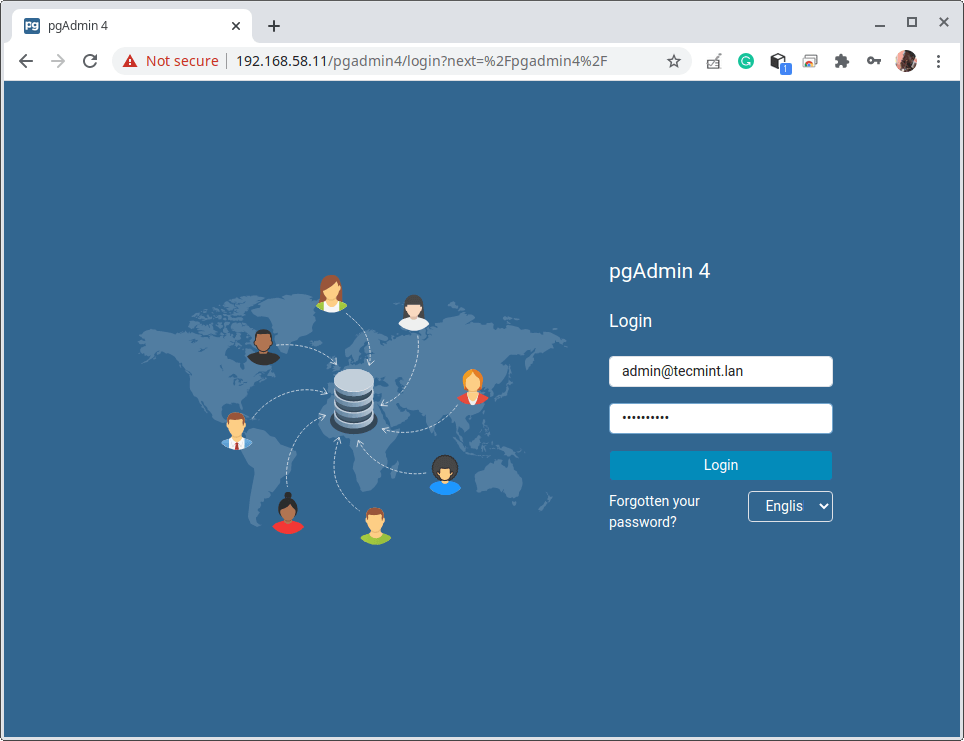
- #Pgadmin 4 for docker how to#
- #Pgadmin 4 for docker install#
- #Pgadmin 4 for docker code#
- #Pgadmin 4 for docker password#
- #Pgadmin 4 for docker windows#
In our case we used NGINX to redirect the access to Kibana (Elasticsearch Dashboard Tool) and PgAdmin4 (PostgreSQL Admin Tool) so that we can access both services on the same port (80) in the browser with different base paths: and docker-compose.yml: version: '3. Click on 'Runtime >' and 'Configure.' The first section is about 'Fixed Port ', v4.x, Click on the pgAdmin 4 tray-icon, Click 'Configure.' Check the box labeled 'Fixed Port Number'. To have one access port (port 80 or 443) you can use a reverse proxy. Because of the change to a standalone application this setting is moved to: Click on 'File v' next to the pgAdmin logo in the top bar.
#Pgadmin 4 for docker how to#
In this tutorial we have seen how to setup PostgreSQl database with docker, how to persist the data and start the database during System startup.If you have multiple services running on Docker with different ports, you have to open ports in your firewall and you have to access the services via different ports in the browser.
#Pgadmin 4 for docker windows#
In Windows system, please check the Start Docker Desktop when you log in option to start Docker daemon at startup. Now if you start the container once even of you restart the system containers will be automatically started again.įor containers with restart policy always to start after reboot, Docker daemon thread should also start at startup.
#Pgadmin 4 for docker code#
postgres-data:/var/lib/postgresql/data ports: - 5432 :5432 networks: - app_net environment: POSTGRES_USER: postgres POSTGRES_PASSWORD: postgres POSTGRES_DB: employee adminer: image: adminer restart: always #restart policy ports: - 8900 :8080 networks: - app_net networks: app_net: driver: bridge Code language: YAML ( yaml ) Version: '3.3' services: postgres: # Official Postgres image from DockerHub image: 'postgres:13.2' restart: always #restart policy volumes:. Assuming the YAML is saved to pgadmin-secret.
#Pgadmin 4 for docker password#
The password is simply base64 encoded (in this case, its SuperSecret ). First login will ask you for a master password for pgAdmin, fill it with your master password and click OK. By clicking at PGAdmin4 icon the extension main window will display the PGAdmin site once it has loaded. This will create a secret with the name pgadmin. Using PGAdmin Docker Extension Once the extension is installed a new extension is listed at the pane Extension (Beta) of Docker Desktop. If you want to start the database container when ever you login into the system we need to set the restart policy to always in compose file. apiVersion: v1 kind: Secret type: Opaque metadata: name: pgadmin data: pgadmin-password: U3VwZXJTZWNyZXQ. With above docker-compose configuration, we have to start the container whenever we want use the database. In server field you need to enter the service name defined in the docker compose file( not localhost) User-friendly interface for data science. We exposed the 5432 port on the host using the -p 5432:5432 in the docker run command.

#Pgadmin 4 for docker install#
To access the database, enter the details like below. SQL OnLine - Next gen SQL Editor: SQLite, MariaDB / MySQL, PostgreSQL, MS SQL Server. I am trying to install pgadmin4 using Docker in Ubuntu 18.04 LTS, but each time I create a container it crashes. By default, the PostgreSQL database runs on the 5432 port. Open the browser and navigate to localhost:8900. You can export & save the list of servers details in a JSON file and after starting. postgres-data:/var/lib/postgresql/data ports: - 5432 :5432 networks: - app_net environment: POSTGRES_USER: postgres # The PostgreSQL user (useful to connect to the database) POSTGRES_PASSWORD: postgres # The PostgreSQL password (useful to connect to the database) POSTGRES_DB: employee # The PostgreSQL default database (automatically created at first launch) adminer: # adminer db client image: adminer restart: always ports: - 8900 :8080 networks: - app_net networks: app_net: driver: bridge Code language: YAML ( yaml )Īfter starting the containers, we can adminer client from from browser. Solved-pgAdmin-4 container connected to PostgreSQL server at boot-docker. The next step is to combine all the ingredients to run the PostgreSQL, passing the postgres-env.list file, specify a volume, define network bridge and drag the crunchy. Until this is solved, or in case you want to run pgAdmin from a Docker container, here’s what worked for me. At this time of writing, pgAdmin4 is not available for installation on Ubuntu 20.04, due to an unresolved Python dependency.

docker network create -driver bridge pgnetwork. Dockerized pgAdmin 4 & local Postgres server on Ubuntu 20.04. Version: '3.3' services: postgres: # Official Postgres image from DockerHub image: 'postgres:13.2' volumes: -. Now we need to connect the PostgreSQL and pgAdmin4 containers, for this we create a network bridge using ‘pgnetwork’.


 0 kommentar(er)
0 kommentar(er)
